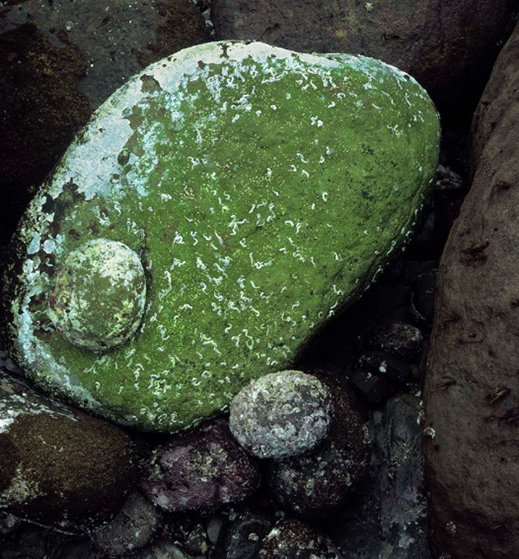 |
|
Here and There introduces art, artists, galleries and museums around Japan that non-Japanese readers and first-time visitors may find of particular interest. The writer claims no art expertise, just a subjective viewpoint acquired over many years' residence in Japan.
|
|
 |
|
|
 |
 |
Shomei Tomatsu: A Glimpse of Genius at FujiFilm Square
Alan Gleason |
 |
|
Shomei Tomatsu, from the series Interface, 1994. © Shomei Tomatsu - INTERFACE |
Over his six-decade career, photographer Shomei Tomatsu (1930-2012) produced a body of work so diverse and influential that it defines the postwar era of Japanese photography. He may be best known for his lifelong project on the city of Nagasaki and his numerous series about Okinawa. His interest in both places had a sociopolitical aspect evident in much of his imagery; his coverage of Nagasaki began in 1961 with a commission from the Japan Council against Atomic and Hydrogen Bombs, while his first Okinawa collection, published in 1969, featured photos of U.S. military bases there when the islands were still under American occupation.
However, a later Okinawa-themed collection, The Pencil of the Sun (1975), reflected Tomatsu's growing interest in the spiritual and cultural side of Okinawan life. It also marks a turning point in Tomatsu's methodology. The book is divided between monochrome photos of Okinawa and color photos from a subsequent trip to Southeast Asia, and from then on he shot in color. But as is suggested by a current exhibition of his work in Roppongi, Tokyo, the more significant transition may have been a thematic one, as Tomatsu began to devote himself less to social commentary (though he continued to revisit Nagasaki and Okinawa) and more to observations of natural phenomena. One catalyst for this shift, according to the exhibition's text, was Tomatsu's heart bypass surgery in 1986, which prompted him to move to the Pacific coast in Chiba, east of Tokyo.
 |
|
Shomei Tomatsu, from the series Interface, 1990. © Shomei Tomatsu - INTERFACE |
This is the side of Tomatsu on display at FujiFilm Square until 30 September in INTERFACE: An Inquiry into the Artistic Practice of Shomei Tomatsu. Though it is a frustratingly small exhibit -- only a dozen photographs from one series, Interface -- it is more than sufficient to demonstrate Tomatsu's brilliance: his complex viewpoint, simultaneously penetrating and whimsical, and his mastery of conception and composition. These are high-resolution close-ups of barnacle-encrusted rocks, clumps of seaweed, and other phenomena observed in the intertidal zone, that narrow band of seashore that is above water at low tide but inundated at high tide. An ever-fluctuating frontier between two ecologies, it is an apt metaphor for various interfaces that Tomatsu addresses in his work: between the self and the world, humanity and nature, life and death.
The Interface project has its origins in a photo titled "Intertidal Zone" that Tomatsu published back in 1966 as part of a magazine series called The Sea Around Us. However, most of the images were shot in the 1990s on the beach near Tomatsu's Chiba home. Prior to that he produced Plastics (1988-89), a series that captured the non-biodegradable flotsam littering Japan's shores -- an overtly critical scrutiny of the interface between human activity and the natural world. Of these objects, Tomatsu declares, "plastics might be the ultimate material to tell future generations about human material culture."
 |
|
Shomei Tomatsu, from the series Plastics, 1988-1989. © Shomei Tomatsu - INTERFACE |
Works from Plastics did, in fact, comprise the first part of the Tomatsu exhibition, which ended in mid-August. Due to space constraints FujiFilm Square divided the show in half, taking down those photos to make room for Interface. An opportunity was thus lost to view Tomatsu's unnervingly lovely portrayals of manmade trash side by side with the more unambiguously lyrical marine imagery of the latter half of the show. Still, it is worth a visit to Roppongi to see this modest yet memorable exhibition while we wait for the next major Tomatsu retrospective.
Though its cramped quarters can be a shortcoming, FujiFilm Square compensates by maintaining a busy and varied schedule of small exhibitions by several photographers at once. The Tomatsu photographs cover just one wall of the venue's Photo History Museum, a corner jam-packed with cameras and film samples that is a must-see for any photography buff. The rest of the gallery space is occupied by the FujiFilm Photo Salon, located for 50 years on the Ginza before it moved to its current site in the Tokyo Midtown complex when FujiFilm Square opened ten years ago. In August the Salon was showcasing the stunning work of Naoki Ishikawa (starkly beautiful scenes from the Arctic islands of Svalbard) and Takehiko Sato (lush color shots of wildlife in the mid-Tokyo oasis of Meiji Jingu shrine). Upcoming shows of note include Hiroshi Yamaguchi's award-winning images of Amazon flora and fauna, opening on 22 September, and Haruo Ohara's monochrome depictions of emigrant life in Brazil, from 1 October.
Cheek by jowl with FujiFilm Square's galleries are a camera showroom and even a FujiFilm Health Care Shop. It's a little crowded, and one wishes that some exhibitions, particularly those introducing work as significant as Tomatsu's, could be afforded more floor space. Be that as it may, the variety of work constantly on display ensures there will be no dull moments for visitors, making the venue a much-appreciated respite from the urban frenzy of Roppongi just outside the showroom windows.
 |
|
Hiroshi Yamaguchi, Rio Japurá, Amazon, Brazil, 2016. |
All images courtesy of FujiFilm Square. |
|
|
| |
 |
Alan Gleason
Alan Gleason is a translator, editor and writer based in Tokyo, where he has lived for 30 years. In addition to writing about the Japanese art scene he has edited and translated works on Japanese theater (from kabuki to the avant-garde) and music (both traditional and contemporary). |
|
|
|
|
|
|
|
|
|
 |
|